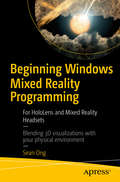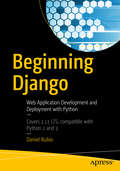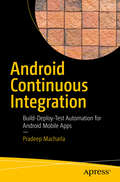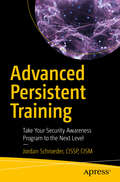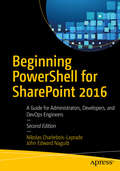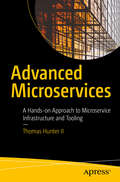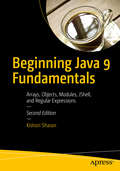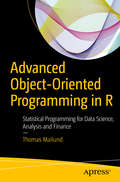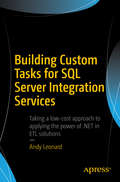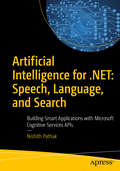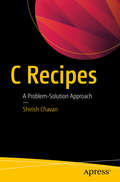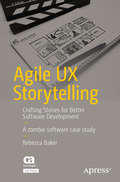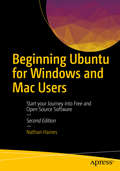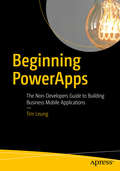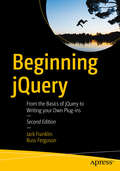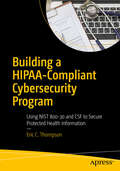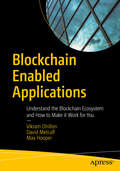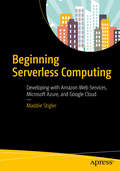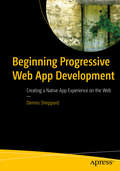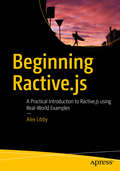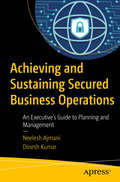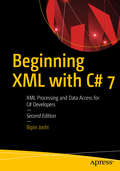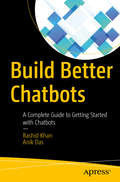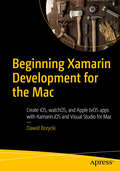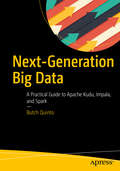- Table View
- List View
Beginning Windows Mixed Reality Programming: For HoloLens and Mixed Reality Headsets
by Sean OngDevelop applications and experiences for Microsoft's HoloLens and other Windows mixed reality devices. This easy-to-follow guide removes the mystery behind creating amazing augmented reality experiences. Mixed reality development tools and resources are provided. Beginning Windows Mixed Reality Programming clearly explains all the nuances of mixed reality software development. You'll learn how to create 3D objects and holograms, interact with holograms using voice commands and hand gestures, use spatial mapping and 3D spatial sound, build with Microsoft's HoloToolkit, create intuitive user interfaces, and make truly awe-inspiring mixed reality experiences. Start building the holographic future today! What You Will Learn Prototype ideas quickly Get started with Unity, the preferred tool for animating 3D objects. Explore where to find 3D models for your project, or make your own! Use spatial sound, voice commands, and gestures Build with the HoloToolkit to make apps the easy way Publish to the Windows Store and make money from your app Who This Book Is For Programmers with little or no graphics or mixed reality experience
Beginning Django: Web Application Development and Deployment with Python
by Daniel RubioDiscover the Django web application framework and get started building Python-based web applications. This book takes you from the basics of Django all the way through to cutting-edge topics such as creating RESTful applications. Beginning Django also covers ancillary, but essential, development topics, including configuration settings, static resource management, logging, debugging, and email. Along with material on data access with SQL queries, you'll have all you need to get up and running with Django 1. 11 LTS, which is compatible with Python 2 and Python 3. Once you've built your web application, you'll need to be the admin, so the next part of the book covers how to enforce permission management with users and groups. This technique allows you to restrict access to URLs and content, giving you total control of your data. In addition, you'll work with and customize the Django admin site, which provides access to a Django project's data. After reading and using this book, you'll be able to build a Django application top to bottom and be ready to move on to more advanced or complex Django application development. What You'll Learn Get started with the Django framework Use Django views, class-based views, URLs, middleware, forms, templates, and Jinja templates Take advantage of Django models, including model relationships, migrations, queries, and forms Leverage the Django admin site to get access to the database used by a Django project Deploy Django REST services to serve as the data backbone for mobile, IoT, and SaaS systems Who This Book Is For Python developers new to the Django web application development framework and web developers new to Python and Django.
Android Continuous Integration: Build-Deploy-Test Automation for Android Mobile Apps
by Pradeep MacharlaMaster continuous integration, deployment and automated testing for Android apps. You'll see how to set up and tear down sandbox environments to test the end-user experience, where you'll learn how to manage a mobile device in addition to the build machine. Android Continuous Integration applies a real-world CI pattern that has been thoroughly tested and implemented. This book starts with continuous integration concepts and the tools and code needed to become proficient in continuous integration for Android apps. You'll also follow acceptance test driven development (ATDD) best practice, giving you all the skills you need to become a better, more effective developer. Finally, you'll learn about the Appium mobile automation library and the Jenkins continuous integration tool. What You Will Learn Understand how to build an Android mobile app from source Set up a development or debuggi ng environment for mobile apps Integrate with the Nexus dependency management and application release tool Work with the SonarQube code quality analyzer Use debugging tools in Android Who This Book Is For Product owners/business analysts, QA/test engineers, developers and build/deploy engineers.
Advanced Persistent Training: Take Your Security Awareness Program to the Next Level
by Jordan SchroederGain greater compliance with corporate training by addressing the heart of the very awareness vs. compliance problem: people are human. People have incredible strengths and incredible weaknesses, and as a Information Security professional, you need to recognize and devise training strategies that take advantage of both. This concise book introduces two such strategies, which combined, can take a security awareness program to the next level of effectiveness, retention, compliance, and maturity. Security policies and procedures are often times inconvenient, technically complex, and hard to understand. Advanced Persistent Training provides numerous tips from a wide range of disciplines to handle these especially difficult situations. Many information security professionals are required by regulation or policy to provide security awareness training within the companies they work for, but many believe that the resulting low compliance with training does not outweigh the costs of delivering that training. There are also many who believe that this training is crucial, if only it could be more effective. What you will learn: Present awareness materials all year-round in a way that people will really listen. Implement a "behavior-first" approach to teaching security awareness. Adopt to gamification the right way, even for people who hate games. Use tips from security awareness leaders addressing the same problems you face. Who is this book for Security awareness professionals or IT Security professionals who are tasked with teaching security awareness within their organization.
Beginning PowerShell for SharePoint 2016: A Guide for Administrators, Developers, and DevOps Engineers
by Nikolas Charlebois-Laprade John Edward NaguibUse the latest tools to manage and automate tasks on Microsoft's SharePoint platform. You will achieve time and cost savings, increase reliability of deployments, and learn how to safely and efficiently migrate from a previous version, all while gaining valuable skills in PowerShell scripting. Authors Nik Charlebois-Laprade and John Edward Naguib begin by explaining the fundamental concepts behind the PowerShell language. Then, with copious real-world examples and scripts, they introduce PowerShell operations in the context of deploying, migrating, managing, and monitoring SharePoint 2016. What You'll Learn What's New in this Edition? Learn about the new SharePoint 2016 capabilities and min role Extend the default set of available PowerShell cmdlets for SharePoint 2016 by creating your own reusable Cmdlet functions with PowerShell 5. 0 Upgrade your on-premises SharePoint 2013 environment to SharePoint 2016 using PowerShell Who This Book Is For Administrators, developers, and DevOps engineers working with SharePoint 2016. No experience with PowerShell is required.
Advanced Microservices: A Hands-on Approach to Microservice Infrastructure and Tooling
by Thomas Hunter IIUse the many types of tools required to navigate and maintain a microservice ecosystem. This book examines what is normally a complex system of interconnected services and clarifies them one at a time, first examining theoretical requirements then looking at concrete tools, configuration, and workflows. Building out these systems includes many concerns such as containerization, container orchestration, build pipelines and continuous integration solutions, automated testing, service discovery, logging and analytics. You will examine each of these tools and understand how they can be combined within an organization. You will design an automated build pipeline from Pull Request to container deployment, understand how to achieve High Availability and monitor application health with Service Discovery, and learn how to collaborate with other teams, write documentation, and describe bugs. Covering use of Jenkins, Docker, Kubernetes, the ELK stack (Elasticsearch, Logstash, and Kibana), and StatsD and Grafana for analytics, you will build on your existing knowledge of Service-Oriented Architecture and gain an advanced, practical understanding of everything from infrastructure development to team collaboration. What You'll Learn Design an API to be convenient for developers to consume. Deploy dynamic instances of Microservices and allow then to discover each other. Track the health of a Microservice and be notified in case of degraded performance. Write effective documentation and communicate efficiently with other teams. Who This Book Is For Those who would like a better understanding of System Oriented Architecture. Those who would like to break a monolith into smaller Microservices. Those who are familiar with Microservices and would like a better understanding of peripheral technologies.
Beginning Java 9 Fundamentals: Arrays, Objects, Modules, JShell, and Regular Expressions
by Kishori SharanLearn the basics of Java 9, including basic programming concepts and the object-oriented fundamentals necessary at all levels of Java development. Author Kishori Sharan walks you through writing your first Java program step-by-step. Armed with that practical experience, you'll be ready to learn the core of the Java language. Beginning Java 9 Fundamentals provides over 90 diagrams and 240 complete programs to help you learn the topics faster. The book continues with a series of foundation topics, including using data types, working with operators, and writing statements in Java. These basics lead onto the heart of the Java language: object-oriented programming. By learning topics such as classes, objects, interfaces, and inheritance you'll have a good understanding of Java's object-oriented model. The final collection of topics takes what you've learned and turns you into a real Java programmer. You'll see how to take the power of object-oriented programming and write programs that can handle errors and exceptions, process strings and dates, format data, and work with arrays to manipulate data. This book is a companion to two other books also by Sharan focusing on APIs and advanced Java topics. What You'll Learn Write your first Java programs with an emphasis on learning object-oriented programming in Java Work with data types, operators, statements, classes and objects Handle exceptions, assertions, strings and dates, and object formatting Use regular expressions Work with arrays, interfaces, enums, and inheritance Deploy Java applications on memory-constrained devices using compact profiles Take advantage of the new JShell REPL tool Who This Book Is For Those who are new to Java programming, who may have some or even no prior programming experience.
Advanced Object-Oriented Programming in R: Statistical Programming for Data Science, Analysis and Finance
by Thomas MailundLearn how to write object-oriented programs in R and how to construct classes and class hierarchies in the three object-oriented systems available in R. This book gives an introduction to object-oriented programming in the R programming language and shows you how to use and apply R in an object-oriented manner. You will then be able to use this powerful programming style in your own statistical programming projects to write flexible and extendable software. After reading Advanced Object-Oriented Programming in R, you'll come away with a practical project that you can reuse in your own analytics coding endeavors. You'll then be able to visualize your data as objects that have state and then manipulate those objects with polymorphic or generic methods. Your projects will benefit from the high degree of flexibility provided by polymorphism, where the choice of concrete method to execute depends on the type of data being manipulated. What You'll Learn Define and use classes and generic functions using R Work with the R class hierarchies Benefit from implementation reuse Handle operator overloading Apply the S4 and R6 classes Who This Book Is For Experienced programmers and for those with at least some prior experience with R programming language.
Building Custom Tasks for SQL Server Integration Services
by Andy LeonardLearn to build custom SSIS tasks using Visual Studio Community Edition and Visual Basic. Bring all the power of Microsoft . NET to bear on your data integration and ETL processes, and for no added cost over what you've already spent on licensing SQL Server. If you already have a license for SQL Server, then you do not need to spend more money to extend SSIS with custom tasks and components. Why are custom components necessary? Because even though the SSIS catalog of built-in tasks and components is a marvel of engineering, there do remain gaps in the functionality that is provided. These gaps are especially relevant to enterprises practicing Data Integration Lifecycle Management (DILMS) and/or DevOps. One of the gaps is a limitation of the SSIS Execute Package task. Developers using the stock version of that task are unable to select SSIS packages from other projects. Yet it's useful to be able to select and execute tasks across projects, and the example used throughout this book will help you to create an Execute Catalog Package task that does in fact allow you to execute a task from another project. Building on the example's pattern, you can create any task that you like, custom tailored to your specific, data integration and ETL needs. What You Will Learn Configure and execute Visual Studio in the way that best supports SSIS task development Create a class library as the basis for an SSIS task, and reference the needed SSIS assemblies Properly sign assemblies that you create in order to invoke them from your task Implement source code control via Visual Studio Team Services, or your own favorite tool set Code not only your tasks themselves, but also the associated task editors Troubleshoot and then execute your custom tasks as part of your own project Who This Book Is For Database administrators and developers who are involved in ETL projects built around SQL Server Integration Services (SSIS). Readers should have a background in programming along with a desire to optimize their ETL efforts by creating custom-tailored tasks for execution from SSIS packages.
Artificial Intelligence for .NET: Building Smart Applications with Microsoft Cognitive Services APIs
by Nishith PathakGet introduced to the world of artificial intelligence with this accessible and practical guide. Build applications that make intelligent use of language and user interaction to better compete in today's marketplace. Discover how your application can deeply understand and interpret content on the web or a user's machine, intelligently react to direct user interaction through speech or text, or make smart recommendations on products or services that are tailored to each individual user. With Microsoft Cognitive Services, you can do all this and more utilizing a set of easy-to-use APIs that can be consumed on the desktop, web, or mobile devices. Developers normally think of AI implementation as a tough task involving writing complex algorithms. This book aims to remove the anxiety by creating a cognitive application with a few lines of code. There is a wide range of Cognitive Services APIs available. This book focuses on some of the most useful and powerful ways that your application can make intelligent use of language. Artificial Intelligence for . NET: Speech, Language, and Search will show you how you can start building amazing capabilities into your applications today. What You'll Learn Understand the underpinnings of artificial intelligence through practical examples and scenarios Get started building an AI-based application in Visual Studio Build a text-based conversational interface for direct user interaction Use the Cognitive Services Speech API to recognize and interpret speech Look at different models of language, including natural language processing, and how to apply them in your Visual Studio application Reuse Bing search capabilities to better understand a user's intention Work with recommendation engines and integrate them into your apps Who This Book Is For Developers working on a range of platforms, from . NET and Windows to mobile devices. Examples are given in C#. No prior experience with AI techniques or theory is required.
C Recipes: A Problem-Solution Approach
by Shirish ChavanSolve your C programming problems with practical and informative recipes. This book covers various aspects of C programming including the fundamentals of C, operators and expressions, control statements, recursion, and user-defined functions. Each chapter contains a series of recipes that you can easily reference to quickly find the answers you are looking for. C Recipes also contains recipes and solutions for problems in memory management, arrays, standard input and output, structures and unions, pointers, self-referential structures, data files, pre-processor directives, and library functions. What You Will Learn Master operators and expressions Write user-defined functions Work with structures and unions Use pointers Define self referential structures Leverage library functions Who This Book Is For Those with some experience in C programming.
Agile UX Storytelling: Crafting Stories for Better Software Development
by Rebecca BakerLearn how to use stories throughout the agile software development lifecycle. Through lessons and examples, Agile UX Storytelling demonstrates to product owners, customers, scrum masters, software developers, and designers how to craft stories to facilitate communication, identify problems and patterns, refine collaborative understanding, accelerate delivery, and communicate the business value of deliverables. Rebecca Baker applies the techniques of storytelling to all facets of the software development lifecycle--planning, requirements gathering, internal and external communication, design, and testing--and shows how to use stories to improve the delivery process. What You'll Learn * Craft stories to facilitate communication within the project team and with stakeholders * Leverage stories to identify problems and patterns, accelerate delivery, and communicate business value * Apply storytelling techniques to all stages of the SDLC * Marshal user stories to focus requirements gathering and ensure a consistent message Who This Book Is For All SDLC and UX roles: product owners, customers, scrum masters, software developers, and UX designers
Beginning Ubuntu for Windows and Mac Users: Start your Journey into Free and Open Source Software
by Nathan HainesBeginning Ubuntu for Windows and Mac Users is your comprehensive guide to using Ubuntu. You already know how to use a computer running Windows or OS X, but learning a new operating system can feel daunting. If you've been afraid to try Ubuntu because you don't know where to start, this book will show you how to get the most out of Ubuntu for work, home, and play. You'll be introduced to a wide selection of software and settings that will make your computer ready to work for you. Ubuntu makes your computing life easy. Ubuntu's Software Updater keeps all of your software secure and up-to-date. Browsing the Internet becomes faster and safer. Creating documents and sharing with others is built right in. Enjoying your music and movie libraries helps you unwind. In addition to a tour of Ubuntu's modern and easy-to-use interface, you'll also learn how to: * Understand the advantages of Ubuntu and its variants--Kubuntu, Xubuntu, and more * Install Ubuntu on its own or alongside your computer's existing operating system * Search Ubuntu's catalog of thousands of applications--all ready to install with a single click * Work with files and disks that were created with Windows and OS X * Run simple, interesting tasks and games using the command line * Customize Ubuntu in powerful ways and get work done with virtual machines Ubuntu is the world's third most popular operating system and powers desktop and laptop computers, servers, private and public clouds, phones and tablets, and embedded devices. There's never been a better time to install Ubuntu and move to an open source way of life. Get started with Beginning Ubuntu for Windows and Mac Users today!
Beginning PowerApps: The Non-Developers Guide to Building Business Mobile Applications
by Tim LeungBuild mobile apps that specifically target your company's unique business needs, with the same ease of writing a simple spreadsheet! With this book, you will build business apps designed to work with your company's systems and databases, without having to enlist the expertise of costly, professionally trained software developers. In Beginning PowerApps, author and business applications expert Tim Leung guides you step-by-step through the process of building your own mobile app. He assumes no technical background, although if you have worked with Excel, you are one step closer. He guides you through scenarios, such as what to do if you have existing databases with complex data structures and how to write screens that can connect to those data. You will come away with an understanding of how to set up screen navigation, manipulate data from within apps, and write solutions to perform specific tasks. What You'll Learn Connect with data Write formulas Visualize your data through charts Work with global positioning systems (GPS) Build flows Import and export data Manage offline scenarios Develop custom application programming interfaces (API) Who This Book Is For Beginners and non-developers, and assumes no prior knowledge of PowerApps
Beginning jQuery: From the Basics of jQuery to Writing your Own Plug-ins
by Russ Ferguson Jack FranklinBeginning jQuery is your step-by-step guide to learning the jQuery library. jQuery is the most popular JavaScript library in the web developer's toolkit. Jack Franklin takes you from the basics of getting you started with jQuery, right through to extending jQuery by writing your own plug-ins. You'll discover best practices you can follow, how you can avoid common mistakes, and you'll learn about so many of the things that jQuery has to offer, including how you can: Use jQuery's powerful tools to dynamically update content on your site, including DOM manipulation. Extend jQuery's capabilities by writing your own plugins on top of the framework. Animate elements and build your own jQuery slider. Employ best practices and avoid common errors made by beginners. JavaScript is a powerful language but every web developer must navigate the tricky issues around cross-browser inconsistencies. Beginning jQuery teaches you how to use jQuery to avoid spending your time fixing these browser bugs - letting you concentrate on what really matters to you. Throughout Beginning jQuery, you'll discover how expressive yet concise jQuery's code is and how much quicker and efficient you can develop with jQuery!
Building a HIPAA-Compliant Cybersecurity Program: Using NIST 800-30 and CSF to Secure Protected Health Information
by Eric C. ThompsonUse this book to learn how to conduct a timely and thorough Risk Analysis and Assessment documenting all risks to the confidentiality, integrity, and availability of electronic Protected Health Information (ePHI), which is a key component of the HIPAA Security Rule. The requirement is a focus area for the Department of Health and Human Services (HHS) Office for Civil Rights (OCR) during breach investigations and compliance audits. This book lays out a plan for healthcare organizations of all types to successfully comply with these requirements and use the output to build upon the cybersecurity program. With the proliferation of cybersecurity breaches, the number of healthcare providers, payers, and business associates investigated by the OCR has risen significantly. It is not unusual for additional penalties to be levied when victims of breaches cannot demonstrate that an enterprise-wide risk assessment exists, comprehensive enough to document all of the risks to ePHI. Why is it that so many covered entities and business associates fail to comply with this fundamental safeguard? Building a HIPAA Compliant Cybersecurity Program cuts through the confusion and ambiguity of regulatory requirements and provides detailed guidance to help readers: Understand and document all known instances where patient data exist Know what regulators want and expect from the risk analysis process Assess and analyze the level of severity that each risk poses to ePHI Focus on the beneficial outcomes of the process: understanding real risks, and optimizing deployment of resources and alignment with business objectives What You'll Learn Use NIST 800-30 to execute a risk analysis and assessment, which meets the expectations of regulators such as the Office for Civil Rights (OCR) Understand why this is not just a compliance exercise, but a way to take back control of protecting ePHI Leverage the risk analysis process to improve your cybersecurity program Know the value of integrating technical assessments to further define risk management activities Employ an iterative process that continuously assesses the environment to identify improvement opportunities Who This Book Is For Cybersecurity, privacy, and compliance professionals working for organizations responsible for creating, maintaining, storing, and protecting patient information
Blockchain Enabled Applications: Understand the Blockchain Ecosystem and How to Make it Work for You
by Vikram Dhillon David Metcalf Max HooperWork with blockchain and understand its potential application beyond cryptocurrencies in the domains of healthcare, Internet of Things, finance, decentralized organizations, and open science. Featuring case studies and practical insights generated from a start-up spun off from the author's own lab, this book covers a unique mix of topics not found in others and offers insight into how to overcome real hurdles that arise as the market and consumers grow accustomed to blockchain based start-ups. You'll start with a review of the historical origins of blockchain and explore the basic cryptography needed to make the blockchain work for Bitcoin. You will then learn about the technical advancements made in the surrounded ecosystem: the Ethereum virtual machine, Solidity, Colored Coins, the Hyperledger Project, Blockchain-as-a-service offered through IBM, Microsoft and more. This book looks at the consequences of machine-to-machine transactions using the blockchain socially, technologically, economically and politically. Blockchain Enabled Applications provides you with a clear perspective of the ecosystem that has developed around the blockchain and the various industries it has penetrated. What You'll Learn Implement the code-base from Fabric and Sawtooth, two open source blockchain-efforts being developed under the Hyperledger Project. Evaluate the benefits of integrating blockchain with emerging technologies, such as machine learning and artificial intelligence in the cloud. Use the practical insights provided by the case studies to your own projects or start-up ideas. Set up a development environment to compile and manage projects. Who This Book Is For Developers who are interested in learning about the blockchain as a data-structure, the recent advancements being made and how to implement the code-base. Decision makers within large corporations (product managers, directors or CIO level executives) interested in implementing the blockchain who need more practical insights and not just theory.
Beginning Serverless Computing: Developing with Amazon Web Services, Microsoft Azure, and Google Cloud
by Maddie StiglerLearn the basics of serverless computing and how to develop event-driven architectures with the three major cloud platforms: Amazon Web Services, Microsoft Azure, and Google Cloud. This hands-on guide dives into the foundations of serverless computing, its use cases, and how to apply it using developer tools such as Node. js, Visual Studio Code, Postman, and Serverless Framework. You will apply the fundamentals of serverless technology from the ground up, and come away with a greater understanding of its power and how to make it work for you. This book teaches you how to quickly and securely develop applications without the hassle of configuring and maintaining infrastructure. You will learn how to harness serverless technology to rapidly reduce production time and minimize your costs, while still having the freedom to customize your code, without hindering functionality. Upon completion, you will have the knowledge and resources to build your own serverless application hosted in AWS, Azure, or Google Cloud and will have experienced the benefits of event-driven technology for yourself. What You'll Learn Gain a deeper understanding of serverless computing and when to use it Use development tools such as Node. js, Postman, and VS code to quickly set up your serverless development environment and produce applications Apply triggers to your serverless functions that best suit the architecture for the problem the functions are solving Begin building applications across cloud providers that utilize the power of serverless technology Understand best development practices with serverless computing to maintain scalable and practical solutions Code with an agnostic approach to cloud providers to minimize provider dependency Who This Book Is For Any developer looking to expand current knowledge of serverless computing, its applications, and how to architect serverless solutions, or someone just beginning in these areas
Beginning Progressive Web App Development: Creating a Native App Experience on the Web
by Dennis SheppardBuild fast, reliable web applications using the latest web development technologies. This book provides step-by-step learning through the process of transforming a "traditional" web app into a high-performing progressive web app, leveraging principles and lessons taught throughout the book. You will learn to improve the performance, reliability, reach, and user engagement of mobile web applications through the use of specific, practical examples. Because most non-trivial web applications developed today use JavaScript frameworks, you will learn about the most popular frameworks offering a PWA right out of the box, including React, Preact, Vue. js, Angular, and Ionic. You also will learn which tools to enlist to measure your application's performance, such as Google's Lighthouse. Beginning Progressive Web App Development includes best practices to make your app work even when an end user has a poor or no Internet connection, and to send notifications and reminders with the Notification and Push APIs to keep your users engaged. You will come away with an understanding of the technologies--application shells, server push technology, and caching--that will allow you to rapidly deliver content to your users. As important as it is to provide mobile users with a great experience, the principles of PWAs are not limited to smartphones. Most of what you will learn in this book is directly applicable to web applications on all screen sizes. What You'll Learn Achieve nearly instant loading times Implement service workers to make your app load faster and work while users are offline Keep users engaged with web notifications Measure the performance and reach of your web applications Transform your existing web app into a progressive web app Create a progressive web app from scratch Understand what building a truly fast web app entails with Google's PRPL pattern Who This Book Is For Web developers with prior JavaScript experience
Beginning Ractive.js: A Practical Introduction to Ractive.js using Real-World Examples
by Alex LibbyDevelop websites using the Ractive. js template-driven UI library. This book is project-oriented and simplifies the process of using Ractive. js to create websites or online applications that are interactive by default. It equips you with a starting toolset to develop future projects, safe in the knowledge that the site operates as expected, and is not reliant on bloated technology, typical of other similar frameworks. Beginning Ractive. js takes the view that you shouldn't always resort to what "everyone else uses", and that there is indeed a different way you can achieve the same result. We live in an age where speed and simplicity are of the essence - this book provides a perfect alternative that challenges the norm. Stop thinking you must use the same library as everyone else. Give Ractive a try! What You'll Learn Understand how Ractive. js works and how it differs to other templating frameworks. templates="" that="" are="" interactive="" from="" the="" outset. Source and manage data using Ractive. js' data binding methods. Gain an appreciation of managing events and animations using Ractive. js. Create components that contain reusability functionality for current or future projects. Work through real-world project examples using the Ractive. js library. Who This Book is For Website developers who are keen to develop a fully interactive, template-driven website quickly, but don't have the desire to learn a more heavyweight framework, such as AngularJS. Agile development teams, where time is of the essence, and the pressure is on to deliver results quickly. Developers who want to focus on simplicity, where the library works for them, and they are not constrained by having to follow a particular methodology.
Achieving and Sustaining Secured Business Operations: An Executive’s Guide to Planning and Management
by Dinesh Kumar Neelesh AjmaniProactively plan and manage innovation in your business while keeping operations safe and secure. This book provides a framework and practices to help you safeguard customer information, prevent unauthorized access, and protect your brand and assets. Securing company operations is a board-level discussion. Across all industries, companies are pouring millions of dollars into taming cybercrime and other related security crime. Achieving and Sustaining Secured Business Operations presents a holistic approach looking top down, bottom up, and sideways. The end goal is to achieve and sustain a safe environment to conduct secured business operations while continuously innovating for competitive advantage. What You'll Learn Discover why security, specifically secured business operations, needs to be part of business planning and oversight by design and not left to technologists to make the business case Determine what you can do in your role and in your organization to drive and implement integration and improvements in planning and managing secured business operations in conjunction with other business planning and management activities Choose ways in which progress toward achieving and sustaining secured business operations can be measured Understand best practices for organizing, planning, architecting, governing, monitoring, and managing secured business operations Create a framework, including methods and tools for operationalizing assessment, planning, and ongoing management of secured business operations Use cases and potential case studies for various industries and business models Who This Book Is For Chief executive officers and their leadership team; chief operations officers; chief information officers and their leadership team; chief information security officers; business functional middle managers; and enterprise, solution, and information technology architects
Beginning XML with C# 7: XML Processing and Data Access for C# Developers
by Bipin JoshiMaster the basics of XML as well as the namespaces and objects you need to know in order to work efficiently with XML. You'll learn extensive support for XML in everything from data access to configuration, from raw parsing to code documentation. You will see clear, practical examples that illustrate best practices in implementing XML APIs and services as part of your C#-based Windows 10 applications. Beginning XML with C# updates Bipin Joshi's one-of-a-kind title to the new C# 7 programming language and . NET 4. 7 Framework releases. In this update, you'll discover the tight integration of XML with ADO. NET and LINQ as well as additional . NET support for today's RESTful web services and microservices. Written by a Microsoft Certified trainer and developer, this book demystifies everything to do with XML and C# 7. What You'll Learn Discover how XML works with the . NET Framework Read, write, access, validate, and manipulate XML documents Transform XML with XSLT Use XML serialization and web services Combine XML in ADO. NET and SQL Server Create services using Windows Communication Foundation Work with LINQ Use XML with C# in Azure and more Who This Book Is For Those with experience in C# and . NET new to the nuances of using XML. Some XML experience is helpful.
Build Better Chatbots: A Complete Guide to Getting Started with Chatbots
by Rashid Khan Anik DasLearn best practices for building bots by focusing on the technological implementation and UX in this practical book. You will cover key topics such as setting up a development environment for creating chatbots for multiple channels (Facebook Messenger, Skype, and KiK); building a chatbot (design to implementation); integrating to IFTT (If This Then That) and IoT (Internet of Things); carrying out analytics and metrics for chatbots; and most importantly monetizing models and business sense for chatbots. Build Better Chatbots is easy to follow with code snippets provided in the book and complete code open sourced and available to download. With Facebook opening up its Messenger platform for developers, followed by Microsoft opening up Skype for development, a new channel has emerged for brands to acquire, engage, and service customers on chat with chatbots. What You Will Learn Work with the bot development life cycle Master bot UX design Integrate into the bot ecosystem Maximize the business and monetization potential for bots Who This Book Is For Developers, programmers, and hobbyists who have basic programming knowledge. The book can be used by existing chatbot developers to gain a better understanding of analytics and the business side of bots.
Beginning Xamarin Development for the Mac: Create iOS, watchOS, and Apple tvOS apps with Xamarin.iOS and Visual Studio for Mac
by Dawid BoryckiDevelop apps for the iPhone, iPad, and Apple wearables using Visual Studio for the Mac. Learn how to set up your development environment and emulators, and how to create adaptive user interfaces for various platforms. Expert Dawid Borycki guides you through the fundamentals of programming for Apple platforms (Model View Controller, Test Driven Development), navigation patterns, gesture handling, accessing user's location, and reading and consuming data from web services. After reading this book, you will be able to build native apps that look and feel like other apps built into iOS, watchOS, and tvOS, and have the skills that are in high demand in today's market. If you are already programming C# apps for web or desktop, you will learn how to extend your skill set to Apple mobile, wearable, and smart TV platforms. What You'll Learn Build and implement native apps for Apple platforms Create adaptive, universal views and handle navigation between them Access user's location and handle touch input Consume data from web services Minimize app development time with C# Who This Book Is For Developers who are interested in mobile and device development, as well as experienced non-Apple developers who want to switch or extend their skill set to programming for Apple platforms
Next-Generation Big Data: A Practical Guide to Apache Kudu, Impala, and Spark
by Butch QuintoUtilize this practical and easy-to-follow guide to modernize traditional enterprise data warehouse and business intelligence environments with next-generation big data technologies. Next-Generation Big Data takes a holistic approach, covering the most important aspects of modern enterprise big data. The book covers not only the main technology stack but also the next-generation tools and applications used for big data warehousing, data warehouse optimization, real-time and batch data ingestion and processing, real-time data visualization, big data governance, data wrangling, big data cloud deployments, and distributed in-memory big data computing. Finally, the book has an extensive and detailed coverage of big data case studies from Navistar, Cerner, British Telecom, Shopzilla, Thomson Reuters, and Mastercard. What You’ll Learn Install Apache Kudu, Impala, and Spark to modernize enterprise data warehouse and business intelligence environments, complete with real-world, easy-to-follow examples, and practical adviceIntegrate HBase, Solr, Oracle, SQL Server, MySQL, Flume, Kafka, HDFS, and Amazon S3 with Apache Kudu, Impala, and SparkUse StreamSets, Talend, Pentaho, and CDAP for real-time and batch data ingestion and processingUtilize Trifacta, Alteryx, and Datameer for data wrangling and interactive data processingTurbocharge Spark with Alluxio, a distributed in-memory storage platformDeploy big data in the cloud using Cloudera DirectorPerform real-time data visualization and time series analysis using Zoomdata, Apache Kudu, Impala, and SparkUnderstand enterprise big data topics such as big data governance, metadata management, data lineage, impact analysis, and policy enforcement, and how to use Cloudera Navigator to perform common data governance tasksImplement big data use cases such as big data warehousing, data warehouse optimization, Internet of Things, real-time data ingestion and analytics, complex event processing, and scalable predictive modelingStudy real-world big data case studies from innovative companies, including Navistar, Cerner, British Telecom, Shopzilla, Thomson Reuters, and MastercardWho This Book Is For BI and big data warehouse professionals interested in gaining practical and real-world insight into next-generation big data processing and analytics using Apache Kudu, Impala, and Spark; and those who want to learn more about other advanced enterprise topics
